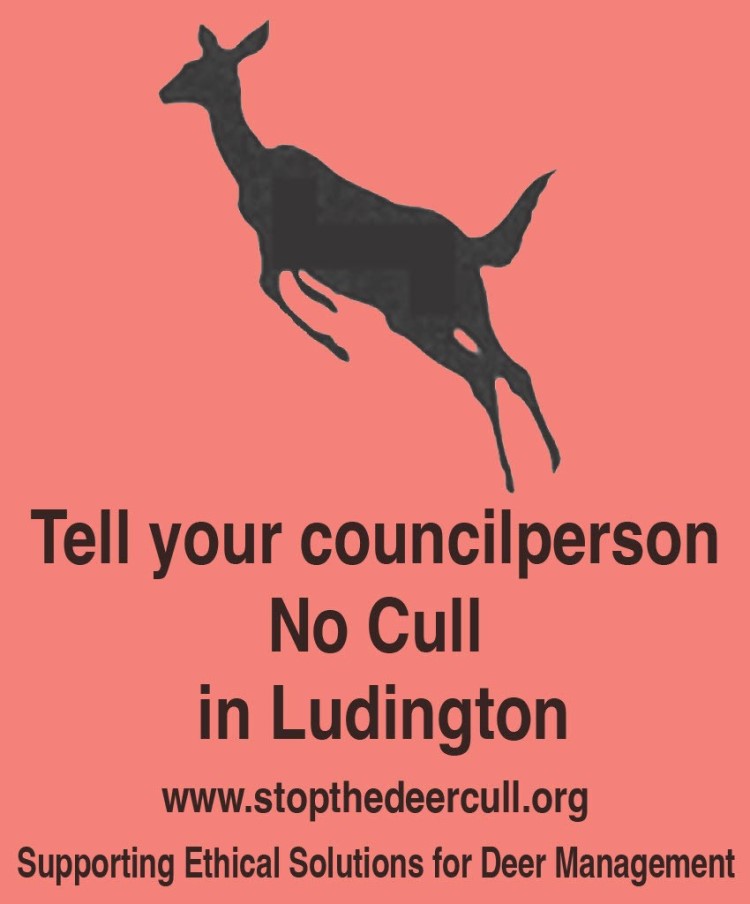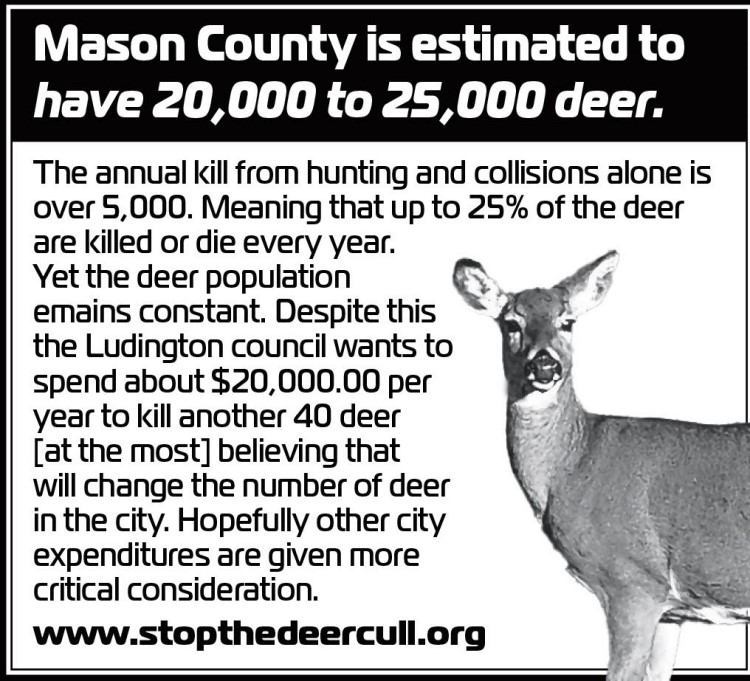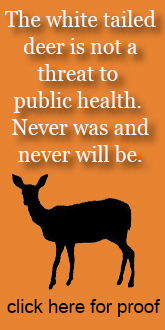Wildlife endures a constant
struggle for survival, where every day is a battle between life and
death. In this natural balance, every action is driven by the need to
survive, not by choice or malice. Yet, human intervention, particularly
through practices like deer culls, adds a layer of senseless violence to
this already harsh reality. Such actions are not only unnecessary but
morally wrong. Killing animals for any reason other than survival is a
grave sin, and those who partake in or support these actions will
ultimately be held accountable by a higher power.
The Department of Natural
Resources (DNR) claims that culling is a method of deer management, but
their track record suggests otherwise. Time and again, they have
demonstrated a lack of true understanding of deer populations and
ecosystems. Their approach is often riddled with misinformation about
diseases and population control, leading to further disruption of
nature’s balance. Every time humans interfere with the natural world,
thinking they can outsmart the wisdom of creation, they end up causing
more harm. Mismanagement creates problems, and further intervention only
exacerbates these issues.
Wildlife management should
prioritize non-lethal methods. Until the DNR adopts a 100% non-lethal
approach, it is irresponsible and unethical to support any form of
wildlife management. True stewardship of the earth requires us to
protect and preserve life, not to destroy it under the guise of
management.
If you want to stop a deer cull you will need
to be prepared to go to court. This takes time so you must start
preparing as soon as you become aware that a deer cull is being
considered.
If you are not claiming economic damages that
are provable you will be challenged on standing by the defense. As a
resident of the area you will have standing but must have done the
following.
-
Challenge to proposed cull
very way you can, for example at city council meetings and at
private meeting with the appropriate officials.
-
express your concerns
By Email and by letter
-
Run advertisements against
the cull in local publication
-
Write letters to the
editors to local newspapers or online publication.
-
You must separate yourself
from the general public's interest. The following information you
should find helpful in formulating your arguments, as it is a motion
to deny a motion for summary judgment based on standing.
Motion in Opposition to Defendant's Motion for Summary Disposition of
Plaintiff’s complaint
and Preliminary Injunction.
1. Plaintiff respectfully moves this honorable Court to deny
the Defendant’s motion for summary disposition of the Plaintiff’s
complaint and Motion for Preliminary Injunction.
2. Plaintiff respectfully submits this response
to the Defendant's motion for summary disposition of the Plaintiff's
complaint, brought forth under Michigan Court Rule 2.116(C)(8) and
(C)(10).
Firstly, regarding Rule 2.116(C)(8), it is imperative to note that the
Plaintiff's complaint sufficiently states a claim upon which relief can
be granted. The allegations contained within the complaint outline a
coherent legal basis for the relief sought, providing specific facts and
legal theories that warrant adjudication. Dismissing the complaint under
this rule would be premature and unjustified.
Furthermore, with respect to Rule 2.116(C)(10), the Defendant asserts
that there is no genuine issue as to any material fact, and thus, they
are entitled to judgment as a matter of law. However, upon careful
review, it becomes apparent that there are indeed factual disputes that
necessitate further examination. The purported lack of genuine issues is
contested by the Plaintiff, and the determination of such issues
warrants a thorough examination of the evidence and legal arguments
presented.
To start with Ordinance 494-22 authorizing the culling of deer states:
1. Section 1: APPROVAL. Pursuant to Section 8.10 of the Charter of the
City of Ludington, the City Council hereby approves the City Manager and
City Clerk to sign a three (3) year Cooperative Service Agreement
between the City of Ludington and United States Department of
Agriculture Animal and Plant Health Inspection Service Wildlife Services
to provide lethal removal of white-tailed deer in areas with high
numbers of complaints and damage.
2. ARTICLE 1 – PURPOSE The purpose of this Cooperative Service Agreement
is to assist the City of Ludington by providing lethal removal of
white-tailed deer in areas with high numbers of complaints and damage.
3. There are no complaints or reports of damage caused by deer in
Cartier Park.
In conclusion, Your Honor, the Defendant's motion for summary
disposition should be denied. The Plaintiff's complaint has adequately
stated a claim for relief, and genuine issues of material fact remain
unresolved. Granting the Defendant's motion at this stage would
prejudice the Plaintiff and undermine the principles of fairness and
justice upon which our legal system is founded.
Brief In Support of Request to Deny Defendant’s Motion for summary
Disposition.
1. The Plaintiff is a resident of Ludington who has presented evidence
to the city council on numerous occasions regarding the folly of urban
deer culls in general. A complaint was filed reluctantly as a last
resort to protect the city from what the Plaintiff believes to be a
serious lack of judgement regarding expending taxpayer resources while
exposing persons to unnecessary numerous potential dangers. The
complaint was not filed to prevent the city from conducting deer culls
but rather to delay a deer cull in Cartier Park until the concerns
related to the potential consequences of the cull in Cartier Park could
be resolved.
2. The Defendant by its attorney has misrepresented many claims made by
the Plaintiff in support of delaying any cull in Cartier Park until such
time as these concerns can be addressed in his verified answers to the
complaint.
3. In response to Michigan Court Rule 2.116(C)(8), I would like to
clarify and address the concerns raised by the plaintiff regarding my
involvement in this matter and the basis of the complaint. Firstly, it
is important to note that my expression of concern regarding the deed
containing a reversion clause in Cartier Park does not stem from any
claim to assert the rights of the heirs of the Cartier family. Rather,
my concern is rooted in the potential consequences of a cull in Cartier
Park triggering the reversion clause. This concern is not contingent
upon my membership or lack thereof in the Cartier family.
4. Furthermore, the basis of the complaint extends beyond the reversion
clause and encompasses several factors that warrant consideration. These
factors include: The ineffectiveness of urban culls as a means of
population control. The absence of evidence provided by the city
demonstrating the necessity of a cull in Cartier Park. Concerns
regarding the possibility of chemical contamination in the park and the
consequences associated with the cull. Safety hazards posed by using
high-powered rifles near a residential area. Alleged violations of city
ordinances prohibiting firearms in and around Cartier Park.
5. Compliance with Michigan state law requiring written permission
for hunting within 450 yards of residences.
6. The plaintiff's familial connection to Mary Elizabeth Cartier, which
may underscore Plaintiff’s interest in the preservation and welfare of
the park. While I am a blood relative, and I am in communication with
Mary regarding Cartier Park and other properties I have never and do not
now claim to be acting on Mary’s behalf.
7. It is imperative to recognize that these concerns collectively
contribute to the foundation of the complaint, rather than solely
relying on the existence of the reversion clause. Therefore, my
involvement in this matter is not aimed at asserting familial rights but
rather at addressing legitimate apprehensions regarding the proposed
actions in Cartier Park. See Exhibit #18
8. Firstly, with regard to the Defendant's assertion of lack of
standing, the Plaintiff maintains that they have a direct interest in
the matter at hand due to their status as a resident of the community
affected by the Defendant's actions. As a resident who frequents Cartier
Park, the Plaintiff has a vested interest in ensuring the preservation
of its natural resources and the protection of its wildlife population.
Therefore, the Plaintiff does indeed have standing to challenge the
Defendant's planned wildlife population management activities. And
contrary to the Defense attorney’s assertion that I am not related to
Mary Elizibeth Cartier I am in fact a blood relative.
9. Additionally, while the Defendant claims that the Plaintiff has
failed to cite applicable law prohibiting the Defendant's actions, it is
important to note that the Plaintiff's concerns are grounded in
principles of environmental conservation, public health, and the
protection of community interests. The Plaintiff contends that the
proposed wildlife management activities may have adverse effects on the
local ecosystem, including potential harm to wildlife populations and
disruption of the park's ecological balance.
10 Furthermore, the Plaintiff does not need to demonstrate personal harm
to establish the basis for injunctive relief. The Plaintiff is seeking
to prevent potential harm to the community as a whole and to preserve
the integrity of Cartier Park for the benefit of all residents. The
potential irreparable harm resulting from the Defendant's actions
extends beyond individual interests and encompasses broader
environmental and community concerns. This potential harm to the
community is demonstrated by the Shoreline Food Club’s refusal to
distribute venison resulting from the cull.
I trust that this clarification provides a comprehensive
understanding of the issues at hand and emphasizes the multifaceted
nature of the complaint. I respectfully contest the assertions made by
the Defendant and seek to clarify the grounds upon which the Plaintiff's
claims are based.
In conclusion, the Plaintiff respectfully asserts that their claims are
valid and well-founded, and requests that the Defendant's motion for
Summary Disposition of Plaintiff’s complaint and Preliminary Injunction
be denied. Additionally, the Plaintiff urges the Court to grant the
motion for temporary and preliminary injunctive relief to prevent
imminent harm to Cartier Park and its surrounding environment. Plaintiff
respectfully requests that this honorable court deny the Defendant's
motion to dismiss the Plaintiff's complaint and motion for temporary and
preliminary injunctive relief.
Thank you for your attention to this matter. I remain available to
provide any further clarification or information as necessary.
By my signature below I affirm that I have read this Verified Answer
to Defendant’s Affirmative Defenses and that my responses to the
contents thereof are true to the best of my information knowledge, and
belief.
For additional details click
here.
Are Animals Evolving Faster
Than Humans?

Recent ad and template
for yard signs to be placed later this year.
Short on time and just want a quick synopsis as to why
we stand against deer culls click here.
Charlevoix, Michigan undertook the foolish step of
starting
deer culls in 2024. If they had reviewed Big Rapids, Michigan
experience of dismal failure with culls having conducted them for
over fifteen years Charlevoix city officials would have known they were
starting to spend taxpayer money on a project that never ends. Simply
put deer culls are USELESS, DANGEROUS AND
EXPENSIVE. The cost of the cull was $600.00 for every deer taken. Not a
very good investment. Click on links for stories on each. Learn more about
the history of the relationship between the white-tailed deer and humans
by
reading this if you do you will not longer support culls if you do
now.
To see how many deer are in
Ludington use the Camera Study Analysis link to the left.
The Michigan DNR publishes a lot of information that contradicts their
claims that deer culls are useful in managing deer. It takes a lot of
work to find the information because this agency proliferates a lot of
publications. For example they continue to claim culls are needed to
control deer populations while publishing this "LANSING, Mich. (WJRT) -
The Michigan Department of Natural Resources is reporting
a significant drop in deer
harvest numbers for the 2023 hunting season. Hunters reported
taking slightly less than 275,000 deer last fall, which is about 9% less
than the more than 300,000 deer culled during the 2022 hunting season".
At the same time According to the Michigan Department of Natural
Resources, approximately 590,000 people obtained a deer tag in Michigan
in 2023, which is 1% more
compared to the previous year. So deer tag sales were up 1%
and the harvest was down over 9%. Does this indicate to you that there
are more deer?
The DNR has a deer management plan that contains many apparent
contradictions and falsehoods. It is long but if you want to understand
the real reason the DNR pushes culls you need to study it. Of course it
is about money "isn't everything".
Get it here
Every deer hunter I talk to reports seeing fewer deer in 2023.
Jesus mentions animals in the Bible in various contexts. For instance,
in Matthew 6:26, Jesus says, “Look at the birds of the air; they do
not sow or reap or store away in barns, and yet your heavenly Father
feeds them. Are you not much more valuable than they?” This verse
highlights God’s care for all living creatures. Animals play a
significant role in the Scriptures, representing both God’s creation and
serving as powerful symbols of spiritual truths. They demonstrate God’s
care for all living creatures and provide us with valuable lessons about
faith, obedience, and stewardship. There is only one justification
for killing an animal and that is when it is necessary for your
survival. To some extent hunting for sport in order to have the
skills necessary to survive may be justifiable. But killing an animal
because it eats your flowers is not.
Scripture teaches us that God tolerated animal sacrifices because of the
seriousness of sin. After Christ atoned for our sins animal sacrifices
were no longer welcomed by God.
Matthew 9:13 Go and learn what this means: ‘I desire mercy, and not
sacrifice.’ For I came not to call the righteous, but sinners.” Hosea
6:6 For I desire steadfast love and not sacrifice, the knowledge of God
rather than burnt offerings.
Killing deer or any animal for that matter because
they eat your flowers is evil. The people that push for culls know this
and that is why they all lie about Lyme Disease, Chronic Wasting Disease
and Overpopulation to justify their evil deed. Check out the facts on
all of these made up excuses to murder deer and you will find they are
all untrue. Add to this made-up stories about coyotes hunting deer in
your city, deer attacking dogs then coming back and breaking into a
house and common sense should tell you how far some people are
willing to go to make someone else protect their precious flowers when
for under $50.00 they could purchase a motion controlled sprinkler and
do it themselves without killing anything. Lazy, stupid, evil, cheap or
cruel pick your reason but it is one of these.

Click on photo to go to our Go Fund Me Page. 100%
goes to paying for advertisements to raise awareness about deer culls
and DNR abuses. Or donate using PayPal below.

If you like reading fiction I suggest you read Mayor Barnett's
article published in the Mason County Press on September 27, 2023.
Click Here Keep in mind that the total Mason Count deer
population is estimated to be about 20,000 deer or roughly 40 deer per
square mile in the 495 square miles of land in the county. The mayor
seems to think there are more than twice the number of deer per square
mile in the city as in the surrounding woodland.
As far as I can determine the USDA does not provide any type of
notice or safety precaution notices when they conduct a deer cull near
your home. You should contact the
Ludington
city manager's office or your council person and demand to know if
there will be any cull activity near your home or where you or your
children might be at risk. Go here for
email and telephone contact information.

Click on photo to see our ad in the Mason County and
Oceana County Press
See who voted for the cull in 2023
Click here
Watch for our new ads in the Ludington Daily News
November 10th

Government bureaucrats always think they can manage
wildlife better than nature, their record on this over time indicates
this to be wrong. For them it is always about money and that is why they
are almost always wrong.
We do not dispute that a territory can become
overpopulated with deer, likewise it can become under populated. Both
conditions have serious effects on the ecology of the territory. Nature
is the best source of maintaining balance but humans are usually too
impatient for this. One of the main problems is that humans rarely
bother to find out what the population of the deer herd is but rather
rely on antidotal evidence derived from random sightings and then always
resort to lethal means to correct a problem that may not even exist.
There are many not lethal ways to remove deer from a territory that work
much better than culls and will not destroy the natural balance.
The
MISSOURI DEPARTMENT OF CONSERVATION has published an excellent study
on this subject. It is not bias like what we get from the Michigan DNR
or the Ludington Mayor and city council it is just factual and
informative.

The following was presented to the city council on November 27th 2023.
We have presented numerous common sense comments about the futility of
deer culls at the Ludington City Council meetings held the second and
forth Mondays at 6:00 PM at the city hall building.
When it comes to reducing the number of deer in the city there is
nothing you or anyone else can do that will accomplish that because of
the way nature has responded to the threats to the White-Tailed Deer’s
survival. The following data taken from DNR published information
illustrates this fact.
The best estimate of the number of deer in Mason County puts the
population at 20,000 to 25,000. There are more deer than people in Mason
County. I guess some of you should be grateful that deer cannot vote.
1. Over 5000 deer are killed each year in Mason County by hunters and
collisions.
2. Plus, an unknown number dies from other causes every year.
3. That means about 25% of the deer population is killed off each year.
4. Notwithstanding this the deer reproduce at a rate that allows the
deer population to remain steady or even increase.
5. Despite these facts the Ludington City Council appears to believe
that killing a few more deer, a maximum of 40, will make a difference in
the urban deer population.
6. The only reduction a deer cull will make is to the city treasury.
7. Urban deer culls are useless, dangerous, and expensive.
8. Do we know who the so called “Sharpshooters” are. Do you know their
names? Have you seen proof of their qualifications? Or are you inviting
armed men to shoot high powered rifles in our town based on something
the government told you? We all know how reliable that is!
9. Please rethink this deer cull and then vote no on wasting our money
and putting us in danger.

|
Finally there is good news. The city
at a recent court hearing announced that there would be no more deer
culls in Ludington. Then on July 8th at the city council meeting
repealed the ordinance authorizing the cull. Hopefully they are persons
of character who will keep this promise.
We continue to work to protect our
deer and Cartier Park.


For updates on the case email us and make the subject
lone Case Update.
The hearing on the defendant's motion for dismissal is
scheduled for June 13, 2024 at 2:30 pm
Read about the biggest
lie told concerning the Ludington Deer Cull:
Click Here

When you cull a doe in January, February or
March what are you really killing.
The following information illustrates that chemical ground water
contamination can and does result in venison that is unsafe to eat.
Since no surface water, soil or vegetation in northwest Ludington
have been tested and that this area has significant ground water
contamination of trichloroethylene (TCE), hexavalent chromium, and
cyanide I urge that all venison resulting from the deer cull in
Ludington be tested for contamination until such time as the other
surface test can be completed.
“The Michigan departments of Health and Human Services (MDHHS)
and Natural Resources (DNR) Thursday issued a ‘Do Not Eat’ advisory for
deer taken within approximately five miles of Clark’s Marsh in Oscoda
Township.”
The advisory is due to high levels of PFOS (perfluoro octane
sulfonic acid) found in a single deer taken about two miles from Clark’s
Marsh, which borders the former Wurtsmith Air Force Base.
Scientists first discovered toxic PFAS contamination at the
former Wurtsmith Air Force base in Oscoda, Michigan, over two decades
ago. From the 1970s until at least the base’s closure in 1993, the Air
Force sprayed PFAS-laden AFFF at Wurtsmith during training exercises to
extinguish fires, and regularly disposed of spent AFFF in grassy areas
of the base.
It should come as no surprise that these
activities caused massive groundwater contamination —
contamination that is running largely unchecked through the Oscoda area
due to the Air Force’s failure to control and clean up the PFAS plumes
from the base.
The question to cull or not to cull is complex and there are
reasonable arguments for both sides of the debate. But one thing is
clear, irresponsible wildlife management by governments at all levels
created the problem in the first place. Now worldwide governments are
using the same bogus arguments to justify culls in a vain attempt to
placate an unhappy citizenry albeit a small but vocal minatory. In
Michigan the DNR is handing off the responsibility for managing deer
herds to local communities by promoting culls and making a profit by
doing so. And gullible local officials are buying it. Culls come at a
high price with no guaranteed results. So the cost can be $500.00,
$1000.00, $2000.00, or more for each deer harvested. If humans stayed
out of it nature would eventually restore the balance but that takes
time and one thing we do not have is patients.
This is an issue all over the world, not just in Ludington or
Michigan or the United States. Read this article about
deer culls in Scotland. It clearly demonstrates why it is futile for
a community like Ludington to waste precious resources trying to do what
an entire nation cannot.
At the local level there is no chance that any effort will have
any meaningful effect on deer population. The DNR knows that they
created a problem that they cannot solve so they are passing it
down to us and others and making money doing so.

Deer culls are a political knee jerk reaction to an issue that
requires a far more complex strategy than just killing the perceived
culprit. I could go into what I suspect is the real reason culls are
advised or suggested as good or suitable by the USDA/DNR but that is not
the reason for this report. Our concern is for the well-being of the
citizens of Ludington, Michigan. Urban deer culls do not contribute to
this, they derogate it.
Title: Analysis of the Ineffectiveness of White-Tailed Deer Culls in
Michigan.
Executive Summary:
White-Tailed deer (Odocoileus virginianus) populations in Michigan have
been subject to culling programs as a means of managing their numbers
and mitigating the associated ecological and agricultural impacts.
However, this report aims to explore and highlight the reasons behind
the apparent ineffectiveness of White-Tailed deer culls in the state.
Various factors contribute to the challenges faced by culling programs,
including ecological dynamics, social aspects, and the practical
difficulties associated with large-scale culling efforts.
1. Ecological Complexity:
• White-Tailed deer populations are influenced by various ecological
factors such as food availability, predation, and weather conditions.
The complexity of these interactions makes it challenging to predict and
control population numbers through culling alone.
• Culling programs often fail to address the root causes of
overpopulation, such as habitat loss and alteration, which can lead to
increased reproductive rates and deer-human conflicts.
2. Reproductive Rates and Migration:
• White-Tailed deer are known for their high reproductive rates, and
culling efforts may not be able to keep up with the natural increase in
population.
• Migration patterns of deer populations can also complicate culling
programs, as individuals from neighboring areas may replenish the culled
populations.
3. Social Resistance and Ethical Concerns:
• Culling programs often face significant social resistance from
communities and animal welfare advocates. Public opposition can lead to
legal challenges, limiting the effectiveness of culling initiatives.
• Ethical concerns surrounding the killing of wildlife, especially
charismatic species like White-Tailed deer, can erode public support for
culling efforts.
4. Inadequate Funding and Resources:
• Culling programs require substantial financial resources and manpower
to be effective. Inadequate funding may result in insufficient
monitoring, data collection, and enforcement, reducing the overall
impact of culling on deer populations.
5. Lack of Comprehensive Management Strategies:
• Successful deer management requires a holistic approach that includes
habitat restoration, public education, and community engagement. Culling
programs, when implemented in isolation, may fail to address these
broader aspects of population control.
6. Monitoring and Evaluation Challenges:
• The effectiveness of culling programs is often difficult to assess due
to inadequate monitoring and evaluation mechanisms. Lack of accurate
data on population dynamics and ecological impacts hinders the ability
to refine and improve culling strategies.
Recommendations:
1. Integrated Management Approach:
• Implement comprehensive deer management strategies that address not
only population control through culling but also habitat restoration,
public education, and community involvement.
2. Public Engagement and Education:
• Develop and implement public awareness campaigns to educate
communities about the ecological impacts of overpopulation and the need
for comprehensive management strategies.
3. Adaptive Management:
• Employ adaptive management practices that allow for continuous
monitoring, evaluation, and adjustment of culling programs based on
scientific evidence and community feedback.
4. Collaboration with Stakeholders:
• Foster collaboration between wildlife agencies, researchers, local
communities, and advocacy groups to build consensus and support for
effective deer management strategies.
5. Research and Innovation:
• Invest in research to better understand the ecological dynamics of
White-Tailed deer populations and explore innovative, non-lethal methods
for population control.
In conclusion, addressing the challenges associated with White-Tailed
deer overpopulation in Michigan requires a multifaceted and adaptive
approach that goes beyond culling. By considering ecological dynamics,
social factors, and ethical considerations, a more sustainable and
effective deer management strategy can be developed and implemented.

The White-Tailed Deer is immune to Lyme disease so obviously cannot
spread it. A tick may hitch a ride but if the deer is alive, you will
not get close enough to it for the tick to jump onto you. The recorded
Lyme disease numbers are very low for Mason County but just because a
case is recorded here does not mean the infection originated here and
vice versa. So it is very difficult to be accurate about how many cases
originate in Mason County.
There has never been a case of Chronic Wasting Disease in Mason County
and very few anywhere in Michigan (the last count I could find prior to
2022 was 18) most of these are farm raised deer in Southeast Michigan,
not in a wild heard. According to the CDC there has never been a case of
a human having it.
In 2022 a total of 10200 deer were tested for CWD and there were 16
positives, 13 of these positive deer came from Gratiot, Ionia, Jackson,
Kent, and Montcalm counties, most from farm raised animals. This may be
part of the 18 referred to above or additional to them I am not sure.
The only way to get an accurate count of the deer population in an area
is a fly over, using Infar red equipment. Grand Haven did this a few
years ago because of claims of hundreds of deer in the city and they
counted fewer than sixty. You cannot accurately calculate the number of
deer in an area.
Comparing crop damage to flower damage is not valid, a yard can be
protected by a $50.00 motion sensor sprinkler. Crops are a farmer’s
livelihood, yet many will not kill the deer. Hazing works much better
for farmers and would for the city but does require some work.
Of course, the current deer in Ludington were not here before us, most
only live five or six years in the wild, a few will live to ten or more
years but historical photographs show many deer taken around here over a
hundred years ago. And I have seen these photos and that is more than I
can say about other photos referred to. When I requested them, I was
told there were none.
Culls are expensive and do not result in fewer deer, once started they
last forever so your tax dollars will be paying for this year after year
while the streets and sidewalks continue to deteriorate. Most of us and
many tourist visit the state park and it is loaded with deer that the
DNR will never allow to be culled. This combined with the entire area
surrounding Ludington being heavily populated with deer makes the idea
of a Ludington cull ludicrous.
Revision of the "NATURAL RESOURCES AND ENVIRONMENTAL PROTECTION
ACT Act 451 of 1994 - (7) An individual shall not hunt with a firearm
within 150 yards of an occupied building, dwelling, house, residence, or
cabin, or any barn or other building used in connection with a farm
operation, without obtaining the written permission of the owner,
renter, or occupant of the property".
By replacing the word hunt with use a firearm and change 150
yards to 400 yards.
Or at the very least mandating that the DNR obey the existing
law.
If you live in Michigan District 2 contact Senator Jon Bumstead
senjbumstead@senate.michigan.gov and Congressman Curt VanderWall
CurtisVanderWall@house.mi.gov and tell them you want the DNR to
follow the law or change the law so they must follow it.
|